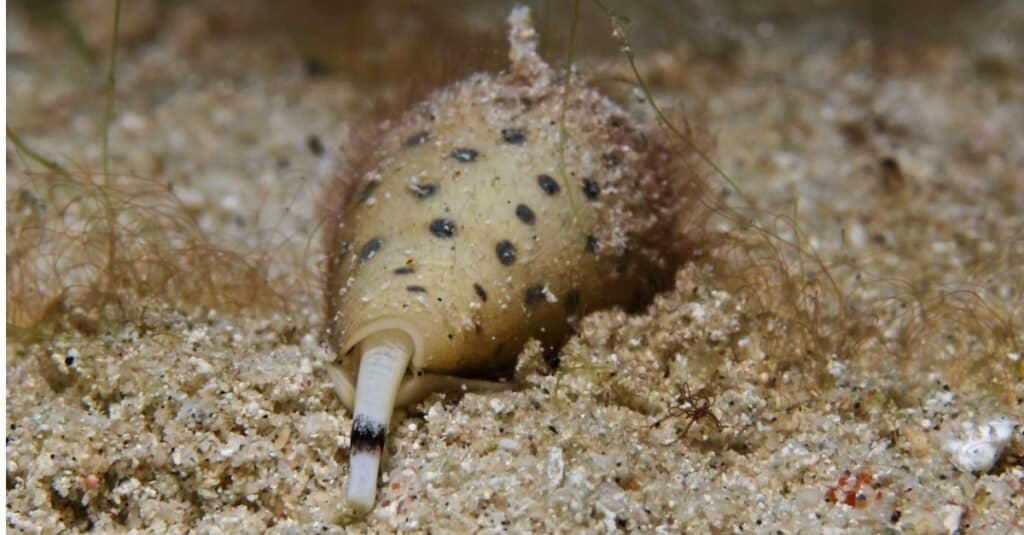
The post This Tiny Snail Is Nature’s Most Underrated Predator appeared first on A-Z Animals.
Snails seem like slow, unassuming animals until you meet the cone snail. This mollusk packs a punch as one of the most predatory and venomous creatures crawling the seafloor. This YouTube video shows some of the devastation they inflict up close, but not all of it. Their true nature is far more violent, calculated, and unexpected for such a tiny sea creature. Here’s how cone snails have become one of the most dangerous hunters in the ocean.
The Cone Snail’s Deadly Anatomy
The most recognizable characteristic of a cone snail is its shell. These come in various colors and patterns, each serving as a warning. There are more than 900 species of cone snails, which vary in length from just under an inch to eight inches. The shell of these snails protects their soft bodies and serves as a defense mechanism against predators. It keeps all their vital organs safe and allows the snail to retreat if necessary. However, it is typically the animals surrounding these snails that should be retreating.
Hidden within that hard shell is a siphon, which appears harmless. Up close, it’s a muscular tube serving several purposes. It helps cone snails breathe underwater by extracting oxygen from the surrounding water. It acts as a built-in filtration system, expelling excess water and waste from the cone snail’s respiratory system. Upon closer inspection, the siphon is covered in chemoreceptors. These are specialized cells capable of detecting motion, which help cone snails sense nearby prey via taste and smell. When it gets close enough, the cone snail unleashes two ultimate weapons hidden within its siphon.
A Hidden Harpoon and Venom
Most fish have no idea they’re about to be speared by a cone snail. The snail’s siphon hides a harpoon-like stinger, known as a radula, that extends and retracts in less than 100 microseconds. This means it’s nearly impossible to follow with the human eye, and prey is hooked and poisoned before it realizes what’s happening. Cone snails that hunt worms have barbed harpoons designed for slower-moving, more stationary prey. Other cone snails, like the one seen in the YouTube video, have harpoons with specialized barbs adapted to catch fast-moving prey.

©iStock.com/scubaluna
Inside the radula is another threat, unknown to the cone snail’s prey: venom. The cone snail is known for injecting a complex, yet unique blend of toxins. Scientists have observed differences in venom between individual cone snails, as well as variations in venom shots from the same animal. All of these venoms are incredibly potent and can paralyze a fish within seconds. When the radula spears a fish, the venom is injected, and the fish is quickly immobilized. As the fish goes limp, the cone snail reels in its radula. At the end of this video, the rostrum—a balloon-like opening—expands around the paralyzed fish while the cone snail swallows it whole.
While every cone snail has a unique venom blend, not every species captures prey similarly. Some cone snails prefer to skewer their prey, inject it with venom, and release the fish, allowing the paralytic to do its job. This is a leisurely but still effective way to hunt. Other species, like the geographer cone snail, release a plume of insulin-laced chemicals into the water. This causes prey to enter an immobilized, coma-like state after experiencing hypoglycemic shock.
Are Cone Snails a Threat to Humans?
In short, the answer is yes. An old saying goes, “If it’s a cone, leave it alone!” This could not be truer of the cone snail. Many people collect their vibrant shells while beachcombing, but touching a shell still attached to a cone snail would spell serious trouble for whoever picked it up. The variety of conotoxins in the cone snail’s venom makes it extremely difficult to create an antivenom, and none exist as of 2025. Its sting is similar to that of a pufferfish, with neurotoxins that can cause extreme pain and shut down organs. Thankfully, cone snails are not naturally aggressive, but treating a sting from one is challenging.
Cone snail venom can cause a range of neuromuscular symptoms. Intense pain, weakness, sweating, numbness, and tingling are usually the first symptoms of a cone snail sting. The venom targets muscle groups, which can lead to paralysis, respiratory failure as it attacks the lungs, and cardiac arrest if it reaches the heart. Since no antivenom currently exists, immediate medical attention is essential, with treatment focused on supportive care and managing symptoms until the venom’s effects subside. Treatment usually involves managing the symptoms of the sting and slowing the circulation of venom. In severe cases, a sting from a cone snail can prove fatal. Since most stings to humans occur when cone snails are handled, it is recommended to leave them alone on the beach and when snorkeling or diving.
The post This Tiny Snail Is Nature’s Most Underrated Predator appeared first on A-Z Animals.
May 02, 2025 at 05:00PMLianna Tedesco
.jpeg)
.jpeg)

0 Comments